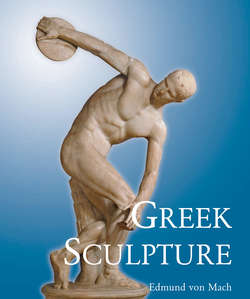Greek Sculpture

Реклама. ООО «ЛитРес», ИНН: 7719571260.
Оглавление
Edmund von Mach. Greek Sculpture
Introduction
Rapidity of Growth
The Triumph of the Few
Small Range of Simple Ideas
The Appeal of a Work of Art
Periods of Greek Sculpure
Fundamental Considerations
Greek Sculpture in its Relation to Nature: The Mental Image
The Appeal of Greek Sculpture
The Artist and his Public
The Principles of Greek Relief Sculpture
Differing Technique of High and Low Relief Sculpture
Greek Relief Sculpture in its Relation to Architecture; Reliefs on Rounded Surfaces
Physical Effort and Pleasure in Viewing Extended Compositions
The Colouring of Greek Sculpture
Art Conditions Before the 7th Century B. C. and Early Ignorance
Material, Technique
Destructive Forces
Early Ignorance of Greek Sculpture
Early Greek Sculpture
First Attempts in the Round
The First Attempts in Relief
Conservatism, Ready Skill Before Freedom of Conception
Transitional Period
Myron
Pythagoras; Telling Use of Details
Grace and Delicate Workmanship; Kalamis
Sculptured Temple Decorations, Aegina and Olympia
Realisation of the Noblest Ideas: the Divine Side of Human Nature
The Parthenon
The Metopes
The Frieze
The Pediments
The Greek Ideal
The Individual Soul and Body
Praxiteles
Skopas
The Niobe Goup
The Tomb of King Mausollos
Formulated Principles; Perfect Skill
Autumn Days
The Aphrodite of Melos
The Nike of Samothrace
The Belvedere Apollo and the Artemis of Versailles
The Laokoön Group
The School of Pargamon
Bibliography
Отрывок из книги
Dipylon Head, Dipylon, Athens, c. 600 B. C. Marble, h: 44 cm. National Archaeological Museum, Athens.
The study of Greek sculpture was unknown two hundred and fifty years ago. Winckelmann[1] was the first to study it, and to publish a book on the subject in 1755. The excavations in Pompeii and Herculaneum, the removal of the Parthenon sculptures to London by Lord Elgin, and above all, the regeneration of Greece and the subsequent rich finds in her soil, added zest to the continually growing interest in this new study.
.....
To a great extent the modelled relief, with its depth of background, has overcome this difficulty, and offers possibilities in this direction not possessed by the older style. To date, however, none of its creations can be said to have been altogether successful. Great depth of reproduction requires the introduction of perspective; and while linear perspective is not incompatible with corporeal representation, aerial perspective is, because it diminishes the distinctness of contours of objects seen at a distance. Another formidable obstacle is the proper treatment of shadows.
It may be safely assumed that the ancients were aware of these difficulties, and therefore somewhat tenacious in their adherence to the practices of the older style, at least in their more pretentious works of art. In minor works, notably in terra cottas, they pushed the tentative beginnings in the other style to a considerable extent. Nothing, however, will do more to clarify the views on Greek relief sculpture than to treat the two styles separately; and since the second style occurs in ancient times only in works of secondary importance, it is best to confine oneself to the carved relief.
.....